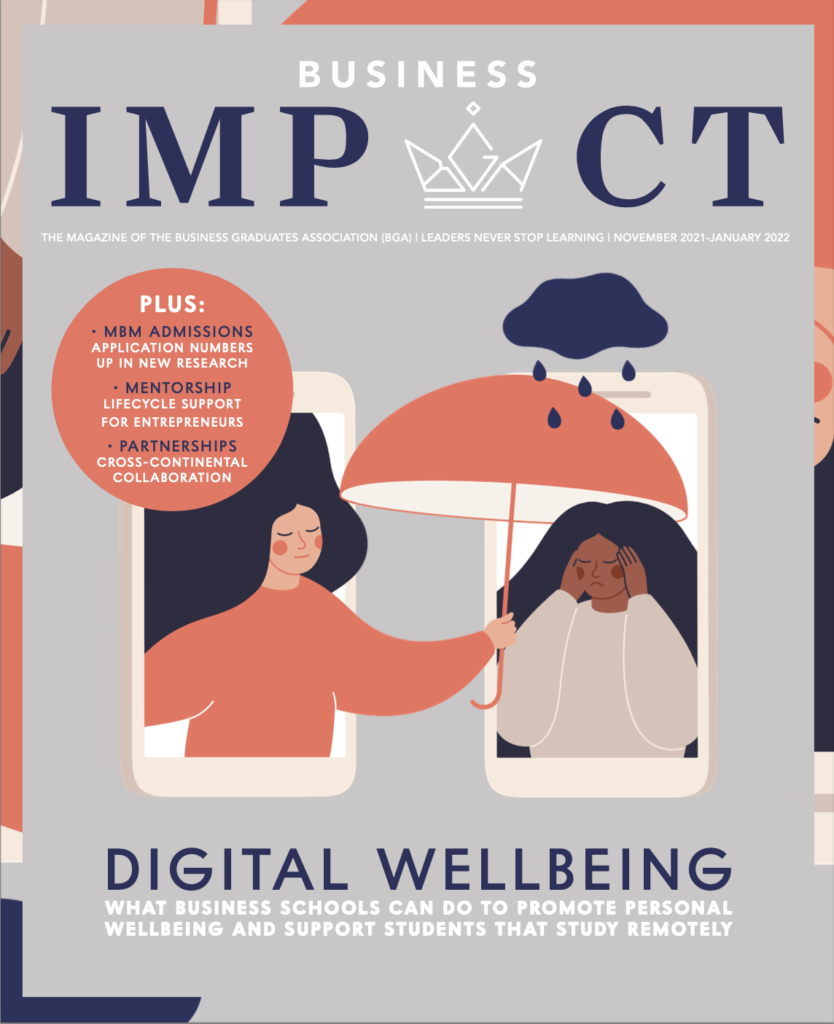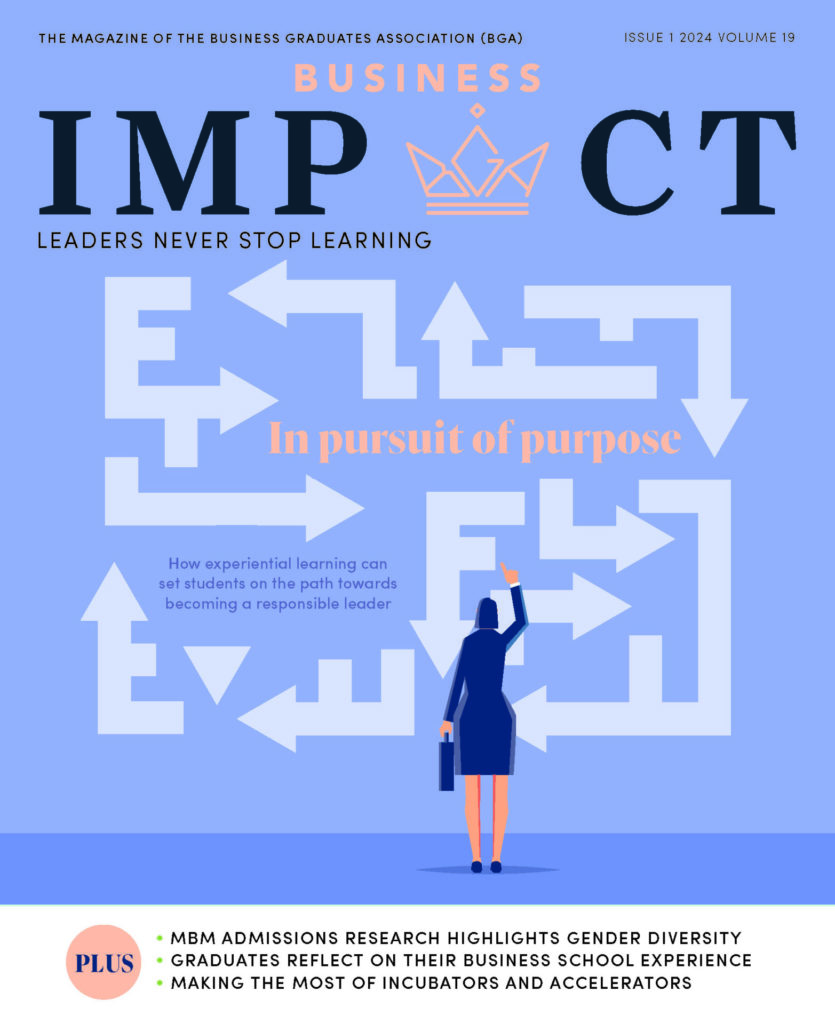In a digital world, there are fewer social cues and fewer resources at hand. This rings true for students as well, meaning that universities and business schools have a responsibility to make sure their graduates are well equipped and ready to thrive in an increasingly online environment.
Having a strong internal system in place to engage students and ensure they have all the information they need is vital. But what should that system look like? Interestingly, a system similar to a social media platform could have a positive impact on students’ wellbeing and social lives.
This article explores these possibilities in further detail and discusses what business schools could be doing to look after the digital wellbeing of this generation of remote and/or blended learners.
New ways of learning are thriving
Traditional approaches to education have evolved rapidly over the last decade. Technology-mediated learning has helped unlock whole new ways of studying, communicating and interacting, providing the flexibility for students to work in a way that suits them best – whether that is on campus, at home, or in their neighbourhood coffee shop.
Even before the Covid-19 pandemic hit, this switch was on the cards. The rise of technology-mediated education had long been in the works with the development of online and blended learning degrees offering students the opportunity to study when and where they want – all they needed was access to a laptop and a half-decent internet connection.
These options were thriving for good reason. From an academic perspective, digital tools can empower students to study flexibly, communicate with other students across the world and open up access to a whole host of research and information tools. Professionally, digital literacy is one of the most important employability skills students can possess – it is increasingly sought after by employers and has been cited in some quarters as crucial to the success of the fourth industrial revolution.
The line between being switched ‘on’ or ‘off’
From an accessibility perspective, it makes sense that the world would move in this direction, as the population becomes increasingly enthralled with its smart devices. Unsurprisingly, perhaps, research has found that around 88% of people use smartphones, and around 95% of these smartphones are used every day, according to Deloitte’s Global Mobile Consumer Survey 2019. Many of us reach for our phones shortly after waking up in the morning, while younger age groups are known to find it hard to put their phones down when they go to bed at night.
And while many traditional business schools emphasise the development of skills and the importance of ensuring the population is confident in using technology for both academic and professional uses, less emphasis has been placed on how students can use technology to promote personal wellbeing and ensure they are looking after themselves when studying remotely.
The danger is that while students may be able to use this technology to catch up on pre-seminar reading on the train home or listen to a lecture at 3am, the line between being switched ‘on’ or ‘off’ can be distorted. This same issue has been reported in workplaces up and down the UK over the last 18 months as the pandemic altered the working practices of professionals across a whole range of sectors, proving it is not an issue that is limited to educational settings.
The concern is that if we’re not looking after wellbeing and encouraging a healthy work-life balance, grades will undoubtedly suffer and we’ll struggle to get the best results for our students.
Indeed, there is compelling evidence which suggests that positive wellbeing in students can be a precursor to outstanding academic achievement, highlighting the importance of looking after our students, as this directly supports the ability to push them to achieve their academic heights.
In this respect, business schools might be missing a key opportunity to support students on their journey of personal growth and academic attainment by under-emphasising the role that digital wellbeing can play. This is vital at this particular moment in time – we find ourselves at a critical juncture as the way we work is scrutinised like never before due to the Covid-19 outbreak.
Addressing the decline in student mental health
The pandemic changed the way we communicate, interact and travel. From a student’s perspective, it disrupted access to lecture theatres and examinations, and prevented opportunities for students to interact with their classmates in typical settings. Put simply, it turned the student experience upside down overnight. A YoungMinds survey recently found that 80% of young people reported a decline in their mental health throughout the pandemic.
It’s a worrying trend and something that we have to take very seriously if we are to ensure that we set these young people up for the best start possible in their careers.
One potential explanation for the decline in student mental health is that they are being required to spend more time sitting behind a computer at home, with fewer opportunities to walk around business school campuses, socialise in person with classmates and travel between two locations as part of their regular day.
Participation in regular physical activity can increase self-esteem and reduce stress and anxiety. It also plays a role in preventing the development of mental health problems and has proven to improve the quality of life of people experiencing mental health problems.
And that’s before you get to the physical issues that can be exacerbated by a lack of physical exercise. Setting up physical competitions, such as walking 10K steps a week, can help break up time spent stationary at a desk, as well as create dialogue between those involved.
Social interaction must be at the centre of solutions
Among the solutions that have been tested are apps that have been designed in collaboration with [secondary/high] schools, students and charities that would allow students to enter data about their wellbeing progress and provide personalised recommendations with access to support from a range of resources.
Such initiatives are backed up by my own research, which found that digital tools can be a viable way of empowering individuals to take control of their health and wellbeing, even when distanced from colleagues and friends. However, there are important factors that must be present in digital interventions to make them appealing to people who are working remotely.
Firstly, there must be an opportunity for social interaction. Static websites that simply display information to the user have limited effectiveness and fail to encourage repeat visits and continued engagement. Generally, these systems find that engagement levels taper down as individuals become bored and begin to disengage with the material.
At this juncture, it’s important to consider the websites that millions of people use daily. The likes of Facebook, Instagram, Twitter and TikTok enable social interactions through carefully curated algorithms that are designed to offer the kinds of content its users are going to like and engage with. They enable these same people to engage in social interactions with their friends, family, colleagues and classmates.
Vitally, they also enable their users to make their own content. Humans are hard-wired to contribute, to share thoughts, ideas and experiences. They are the experts of their own lives and so providing a platform where conversations, photographs and other media relating to a topic can be shared naturally promotes engagement and involvement.
‘Off the shelf’ options can only go so far
Ultimately, the development of any technological solution should be a collaborative process between business schools and students. Each party should work with the other to co-create their educational experience and explore how student wellbeing can be enhanced. Every business school has unique opportunities, resources and challenges. While ‘off the shelf’ interventions may be available for universities to purchase, they can only go so far.
To see real change, localised solutions that can accommodate the resources, opportunities and unique student demographics of each business school may be required. Co-creating digital wellbeing tools with students, rather than for students, can allow organisations to tap into a breadth of knowledge, experiences and ideas. This will make the content more relevant and highlight problems and solutions that may not previously have even been on the school’s radar.
This is where the inclusion of social media elements into digital wellbeing tools can help again. The inclusion of these elements into digital wellbeing tools opens up the possibility of tailoring the information that can be accessed – enabling individuals to join groups that most resonate with them while spending less time wading through topics or discussions that are not of interest – particularly important for students on business courses which are well-known for their demanding nature. Much like the static website, it’s important to not overwhelm users with too much information as this can lead to choice fatigue and disengagement, discouraging people from accessing the very interventions that have been put in place to support them.
When actively managed, social media-style platforms can promote support and ownership. A business environment is highly competitive, so setting up friendly competitions and challenges for students will not only get students moving, but also bring out teamwork and collaboration. It is a co-operative and supportive way to get students to feel like they are part of a team.
Platforms can also be adapted to include elements of gamification to promote engagement. Virtual badges, unlocking achievements and digital certificates can create a sense of progress and achievement towards a goal. Indeed, skills badges and certificates have already begun to permeate professional business platforms such as LinkedIn. The same principles can be applied to enhance engagement in business school settings.
Tracking engagement and refining systems
It needn’t be laborious for students either. With a good internal digital social system in place, you can track engagement and see what is working for users and what isn’t. Is the virtual art night not working? That’s fine – perhaps try a yoga challenge. Has a student thought of a quirky new idea? Ensure that they have a space to share it with others. Is no one clicking on that super awesome page full of tips and tricks? Then maybe the business school can revisit its design.
Often, you will find that those who may not typically engage in particular activities in the physical world, will do so virtually. The online disinhibition effect (where people can feel safer communicating thoughts and ideas online than in person), may help us hear the voices of those who are unheard in more traditional approaches to student wellbeing. It will provide comfort for the more introverted; using digital systems is more adaptable than traditional social events and interventions, meaning that groups that wouldn’t necessarily mix in person, will have a chance to do so virtually.
Education has changed rapidly since the pandemic and student experiences have changed rapidly too. While many business schools are taking active steps to support the academic and professional wellbeing of students, the importance of digital wellbeing may be less apparent.
However, socially interactive digital tools can provide a lifeline for students in both protecting their own personal wellbeing and connecting them to a wider learning community. Given that poor mental health and physical inactivity have been associated with poorer academic performance, the importance of actively engaging with student digital wellbeing cannot be understated.









